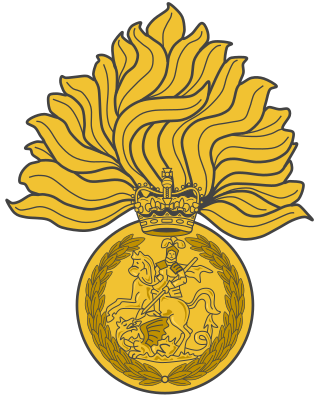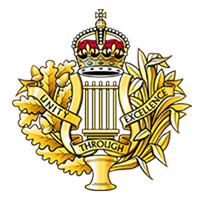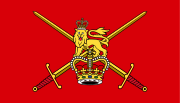The Infantry of the British Army comprises 49 infantry battalions, from 19 regiments. Of these, 33 battalions are part of the Regular army and the remaining 16 a part of the Army Reserve. The British Army's Infantry takes on a variety of roles, including armoured, mechanised, air assault and light.

The Royal Regiment of Fusiliers is an infantry regiment of the British Army, part of the Queen's Division. Currently, the regiment has two battalions: the 1st Battalion, part of the Regular Army, is an armoured infantry battalion based in Tidworth, Wiltshire, and the 5th Battalion, part of the Army Reserve, recruits in the traditional fusilier recruiting areas across England. The Royal Regiment of Fusiliers was largely unaffected by the infantry reforms that were announced in December 2004, but under the Army 2020 reduction in the size of the Army, the 2nd Battalion was merged into the first in 2014.
Options for Change was a restructuring of the British Armed Forces in summer 1990 after the end of the Cold War.
The 2003 Defence White Paper, titled Delivering Security in a Changing World, set out the future structure of the British military, and was preceded by the 1998 Strategic Defence Review (SDR) and the 2002 SDR New Chapter, which responded to the immediate challenges to security in the aftermath of the September 11 attacks in 2001. Published under the then Secretary of State for Defence, Geoff Hoon, the report effectively introduced a series of cutbacks to core equipment and manpower and the scaling back of a series of future capital procurement projects. This was justified due to the implementation of a policy termed Network Enabled Capability. The review also outlined a major restructuring and consolidation of British Army Infantry regiments.

The Princess of Wales's Royal Regiment is the senior English line infantry regiment of the British Army, second in the line infantry order of precedence to the Royal Regiment of Scotland and part of the Queen's Division.

The Royal Corps of Army Music is a Corps of the British Army dedicated to the provision and promotion of military music.

The Royal Welsh is an armoured infantry regiment of the British Army. It was established in 2006 from the Royal Welch Fusiliers and the Royal Regiment of Wales.

The Queen's Regiment (QUEENS) was an infantry regiment of the British Army formed in 1966 through the amalgamation of the four regiments of the Home Counties Brigade. Then, until 1971 the regiment remained one of the largest regiments in the army, with 10 battalions, however these were reduced to just six, and later five battalions. Following the dissolution of the Soviet Union, the Options for Change reform was published and the regiment amalgamated with the Royal Hampshire Regiment to form the Princess of Wales's Royal Regiment.
The Rifles is an infantry regiment of the British Army. Formed in 2007, it consists of four Regular battalions and three Reserve battalions. Each Regular battalion of The Rifles was formerly an individual battalion of one of the two large regiments of the Light Division. Since formation, the regiment has been involved in combat operations in the later stages of the Iraq War and in the War in Afghanistan.
The Prince of Wales's Division was a British Army command, training and administrative apparatus designated for all land force units in the West of England and Wales. It merged with the Scottish Division, to form the Scottish, Welsh and Irish Division; at the same time the Mercian Regiment joined with the King's Division.
The British Army is listed according to an order of precedence for the purposes of parading. This is the order in which the various corps of the army parade, from right to left, with the unit at the extreme right being highest. Under ordinary circumstances, the Household Cavalry parades at the extreme right of the line. Militia and Army Reserve units take precedence after Regular units with the exception of The Honourable Artillery Company and The Royal Monmouthshire Royal Engineers.

The 7th Light Mechanised Brigade Combat Team is a formation in the British Army with a direct lineage to 7th Armoured Brigade and a history that stretches back to the Napoleonic Wars. It saw active service in the Crimean War, the Second Boer War and both the First and the Second World Wars. In 2014, the 7th Armoured Brigade was re-designated as 7th Infantry Brigade, thereby ensuring that the famed "Desert Rats" continue in the British Army's Order of battle.

The Royal Regiment of Scotland is the senior and only current Scottish line infantry regiment of the British Army Infantry. It consists of three regular and two reserve battalions, plus an incremental company, each formerly an individual regiment. However, three regular battalions maintain their former regimental pipes and drums to carry on the traditions of their antecedent regiments.

The 11th Security Force Assistance Brigade is a brigade of the British Army which is intended to train and assist foreign forces. In 2021, under the Future Army changes, the brigade was redesignated, formerly being the 11th Infantry Brigade & HQ South East. Prior to the Army 2020 changes in 2013, the brigade was temporarily activated for deployment to Afghanistan. Originally formed in the Second Boer War, the brigade was engaged during both World Wars.

The 49th Infantry Brigade, later known as 49th (Eastern) Infantry Brigade during the Cold War, was a brigade of the British Army.

Minden Day is a regimental anniversary celebrated on 1 August by certain units of the British Army. It commemorates the participation of the forerunners of the regiments in the Battle of Minden during the Seven Years' War on that date in 1759.
A large regiment is a multi-battalion infantry formation of the British Army. First formed in the 1960s, large regiments are the result of the amalgamation of a number of existing single-battalion regiments, and perpetuate the traditions of each of the predecessor units.

The Union Division is an administrative unit of the British Army responsible for the training and administration of regiments of line infantry.
















